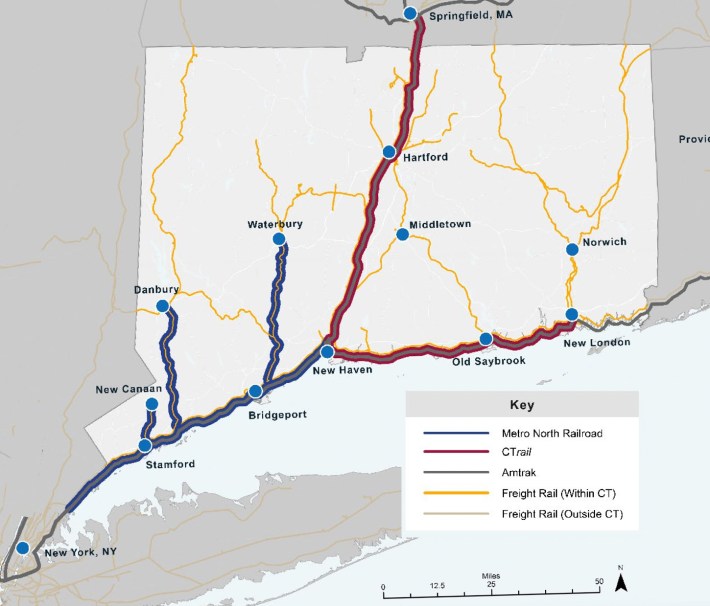He's made his bet.
Connecticut Gov. Ned Lamont announced last month a $315-million investment in 60 state-of-the-art commuter rail cars — but they're not going anywhere near Grand Central along Metro-North's New Haven Line. No, these cars will roll out in 2026 along the intra-state Danbury and Waterbury branches, as well on the Hartford Line, which links the state capital and Springfield, Mass.
Meanwhile, Connecticut has proposed slashing $40 million from the New Haven Line — the busiest passenger rail line in North America — citing lingering declines from the pandemic. The cuts in funding and service are "deeply concerning," said the state's flagship paper, the Hartford Courant.
But this tale of two train lines makes sense from two perspectives: building communities and bolstering economic competitiveness inside the state. CT Rail’s Hartford Line opened in 2018, linking the Bay State and Nutmeg State cities at speeds of up to 110 mph. It’s become a remarkable case study in how passenger rail can help smaller cities curb car culture and punch above their weight. After all, a train speeding through the Connecticut River Valley outperformed the New Haven Line’s post-pandemic ridership recovery by nearly 10 percent.

“If COVID has taught us anything about ridership patterns, it’s that there is a huge thirst for intrastate rail travel,” said Connecticut Commuter Rail Council Chairman Jim Gildea. “The two lines that, without question, have done the best in retaining their pre-COVID ridership bases were the Waterbury branch line, which has actually exceeded COVID ridership in some cases, and the Hartford line, which is pretty close.”
The Hartford Line project began in earnest in 2010, when Connecticut received $40 million in the Obama stimulus to double track 10.5 miles of the route. Then-Gov. Jodi Rell, a Republican, doubled down and pursued $260 million in bonds to double track the whole 179-year-old rail line then only lightly served by Amtrak alone. That rail corridor was originally double tracked, but Amtrak removed the second track in the 1980s to cut maintenance costs as new interstate highways sapped rail ridership. A year after opening, the Hartford Line punched back carrying 730,589 passengers along the route that runs parallel to I-91. This wasn’t even the first time in Connecticut that commuters ditched traffic for trains when given the chance.
Maintenance on I-95 in Eastern Connecticut promised serious congestion, and the state initiated a temporary rail service now known as the Shore Line East between Old Saybrook and New Haven that became effectively permanent in 1996. It caught on, prompting an extension to its current terminus in New London. Before the pandemic, there were 18 Shore Line East trains running in each direction every weekday with 10 on the weekends. Today, there are only eight, and the Lamont administration is seeking further cuts there, as well.
“[Lamont’s rail policy is] really an interesting dynamic,” Gildea said. “Because everywhere else when service was given, ridership came back in droves. The Shore Line East, was never given that chance. … And then, the state started to say, 'Well, geez, there's no ridership there.' Of course there's no ridership there, they were never given an opportunity. And now we're gutting them even more. It's very disappointing, and really it's in direct conflict with the investment we're making in rail everywhere else.”
The Lamont administration and the transportation committee chairs in both houses of Connecticut’s legislature did not respond to requests for comment.
New London Mayor Michael Passero, like Lamont, a Democrat, said the state’s policy is a “self-fulfilling prophecy,” and that Hartford has left the Eastern part of the state feeling overlooked. Still, Passero and Gildea are among many who plan to keep boots on the ground and petition the state to restore and even expand service.
Just this month, CTDOT released its Eastern Connecticut Rail and Transit Feasibility Study exploring a new rail branch to Norwich — increasing transit access for rural parts of the state and the 15,000-plus employees at the nearby Foxwoods and Mohegan Sun casinos — and an eastward Shore Line East extension to Westerly, RI. Advocates believe this is just one way to spur development and get people out of cars simply by replicating the Hartford Line recipe, that is, augmenting existing rail corridors to deliver inter-small city passenger rail.
Transportation for America Chairman John Robert Smith mentioned three principles for getting these projects to the finish line.
“Those connections, even within the borders of one state, have tremendous economic potential for every stop along the line,” Smith said. “So it's a sustained vision, understanding the economic impact of each stop, and then thirdly, it's understanding the basic connectivity that your citizens will experience. … I want other parts of the state to feel left out, and to feel, in effect, jealous so that they will work to accomplish [that] kind of connectivity.”
Smith believes Connecticut’s successes are exportable, and its pitfalls are avoidable. He recalled the return on investment from the multimodal transportation center he spearheaded during his time as mayor of Meridian, Miss.
“For every dollar we put in that station,” Smith said, “we've leveraged now something like $196 in additional investment. … Give me 196-to-one every day. … I would venture that most folks that are involved in this discussion in Connecticut might not think they can learn anything from Mississippi and Louisiana. They'd be wrong.”
The Connecticut DOT will hold four public hearings, starting Monday, at locations across the state. Click here for more info on the meetings or the proposed cuts.






